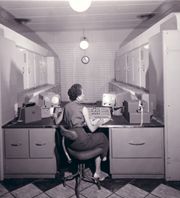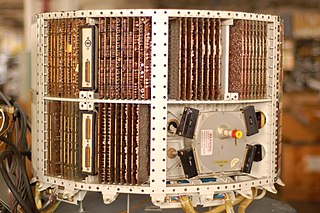Related Research Articles
The bit is the most basic unit of information in computing and digital communications. The name is a portmanteau of binary digit. The bit represents a logical state with one of two possible values. These values are most commonly represented as either "1" or "0", but other representations such as true/false, yes/no, on/off, or +/− are also widely used.

The IBM 1620 was announced by IBM on October 21, 1959, and marketed as an inexpensive scientific computer. After a total production of about two thousand machines, it was withdrawn on November 19, 1970. Modified versions of the 1620 were used as the CPU of the IBM 1710 and IBM 1720 Industrial Process Control Systems.

The UNIVAC I was the first general-purpose electronic digital computer design for business application produced in the United States. It was designed principally by J. Presper Eckert and John Mauchly, the inventors of the ENIAC. Design work was started by their company, Eckert–Mauchly Computer Corporation (EMCC), and was completed after the company had been acquired by Remington Rand. In the years before successor models of the UNIVAC I appeared, the machine was simply known as "the UNIVAC".

The IBM 650 Magnetic Drum Data-Processing Machine is an early digital computer produced by IBM in the mid-1950s. It was the first mass-produced computer in the world. Almost 2,000 systems were produced, the last in 1962, and it was the first computer to make a meaningful profit. The first one was installed in late 1954 and it was the most popular computer of the 1950s.

The IBM 700/7000 series is a series of large-scale (mainframe) computer systems that were made by IBM through the 1950s and early 1960s. The series includes several different, incompatible processor architectures. The 700s use vacuum-tube logic and were made obsolete by the introduction of the transistorized 7000s. The 7000s, in turn, were eventually replaced with System/360, which was announced in 1964. However the 360/65, the first 360 powerful enough to replace 7000s, did not become available until November 1965. Early problems with OS/360 and the high cost of converting software kept many 7000s in service for years afterward.

The Ferranti Mark 1, also known as the Manchester Electronic Computer in its sales literature, and thus sometimes called the Manchester Ferranti, was produced by British electrical engineering firm Ferranti Ltd. It was the world's first commercially available electronic general-purpose stored program digital computer.

The IBM 305 RAMAC was the first commercial computer that used a moving-head hard disk drive for secondary storage. The system was publicly announced on September 14, 1956, with test units already installed at the U.S. Navy and at private corporations. RAMAC stood for "Random Access Method of Accounting and Control", as its design was motivated by the need for real-time accounting in business.
The Burroughs B2500 through Burroughs B4900 was a series of mainframe computers developed and manufactured by Burroughs Corporation in Pasadena, California, United States, from 1966 to 1991. They were aimed at the business world with an instruction set optimized for the COBOL programming language. They were also known as Burroughs Medium Systems, by contrast with the Burroughs Large Systems and Burroughs Small Systems.

International Computers and Tabulators or ICT was a British computer manufacturer, formed in 1959 by a merger of the British Tabulating Machine Company (BTM) and Powers-Samas. In 1963 it acquired the business computer divisions of Ferranti. It exported computers to many countries and in 1968 became part of International Computers Limited (ICL).
The ICT 1301 and its smaller derivative ICT 1300 were early business computers from International Computers and Tabulators. Typical of mid-sized machines of the era, they used core memory, drum storage and punched cards, but they were unusual in that they were based on decimal logic instead of binary.
The DRTE Computer was a transistorized computer built at the Defence Research Telecommunications Establishment (DRTE), part of the Canadian Defence Research Board. It was one of the earlier fully transistorized machines, running in prototype form in 1957, and fully developed form in 1960. Although the performance was quite good, equal to that of contemporary machines like the PDP-1, no commercial vendors ever took up the design, and the only potential sale to the Canadian Navy's Pacific Naval Laboratories, fell through. The machine is currently part of the Canadian national science and technology collection housed at the Canada Science and Technology Museum.
The FP-6000 was a second-generation mainframe computer developed and built by Ferranti-Packard, the Canadian division of Ferranti, in the early 1960s. It is particularly notable for supporting multitasking, being one of the first commercial machines to do so. Only six FP-6000s were sold before the computer division of Ferranti-Packard was sold off by Ferranti's UK headquarters in 1963, the FP-6000 becoming the basis for the mid-range machines of the ICT 1900, which sold into the thousands in Europe.

The NCR 315 Data Processing System, released in January 1962 by NCR, is a second-generation computer. All printed circuit boards use resistor–transistor logic (RTL) to create the various logic elements. It uses 12-bit slab memory structure using magnetic-core memory. The instructions can use a memory slab as either two 6-bit alphanumeric characters or as three 4-bit BCD digits. Basic memory is 5000 "slabs" of handmade core memory, which is expandable to a maximum of 40,000 slabs in four refrigerator-size cabinets. The main processor includes three cabinets and a console section that houses the power supply, keyboard, output writer, and a panel with lights that indicate the current status of the program counter, registers, arithmetic accumulator, and system errors. Input/Output is by direct parallel connections to each type of peripheral through a two-cable bundle with 1-inch-thick cables. Some devices like magnetic tape and the CRAM are daisy-chained to allow multiple drives to be connected.

The Elliott 803 is a small, medium-speed transistor digital computer which was manufactured by the British company Elliott Brothers in the 1960s. About 211 were built.
The Little Man Computer (LMC) is an instructional model of a computer, created by Dr. Stuart Madnick in 1965. The LMC is generally used to teach students, because it models a simple von Neumann architecture computer—which has all of the basic features of a modern computer. It can be programmed in machine code or assembly code.

The D-17B (D17B) computer was used in the Minuteman I NS-1OQ missile guidance system. The complete guidance system contained a D-17B computer, the associated stable platform, and power supplies.
The D-37C (D37C) is the computer component of the all-inertial NS-17 Missile Guidance Set (MGS) for accurately navigating to its target thousands of miles away. The NS-17 MGS was used in the Minuteman II (LGM-30F) ICBM. The MGS, originally designed and produced by the Autonetics Division of North American Aviation, could store multiple preprogrammed targets in its internal memory.
The Orion was a mid-range mainframe computer introduced by Ferranti in 1959 and installed for the first time in 1961. Ferranti positioned Orion to be their primary offering during the early 1960s, complementing their high-end Atlas and smaller systems like the Sirius and Argus. The Orion was based on a new type of logic circuit known as "Neuron" and included built-in multitasking support, one of the earliest commercial machines to do so.

The Manchester Mark 1 was one of the earliest stored-program computers, developed at the Victoria University of Manchester, England from the Manchester Baby. Work began in August 1948, and the first version was operational by April 1949; a program written to search for Mersenne primes ran error-free for nine hours on the night of 16/17 June 1949.
The City & Guilds Mnemonic Code and its associated City & Guilds Computer was a specification for an assembler language and a virtual computer system that ran it. It was introduced in 1964 by the City and Guilds of London Institute and used as the basis for a number of computer programming and administration courses. The computer model was deliberately very simple, and operational systems were implemented as interpreters on a number of mainframe computers like the ICL 1900 series and Elliot 900 family. An updated version was released in 1968.
References
Citations
- 1 2 "COMPUTER AND DATA PROCESSING, NORTH AMERICA: SIRIUS – FERRANTI ELECTRIC, INC. – HEMPSTEAD L.I., NEW YORK". Digital Computer Newsletter. 11 (3): 1. Jul 1959.
- ↑ "Univac Solid State 80/90 Magnetic Amplifier and Experimental Board"
- 1 2 3 4 5 6 7 Scarrott
- ↑ See UNIVAC Solid State for one example.
- ↑ Gordon Scarrott, "From Torsional Mode Delay Lines to DAP", Computer Resurrection, Number 12 (Summer 1995)
- 1 2 3 Hall
- ↑ Barbara Ainsworth, "The Ferranti Sirius at Monash University", Computer Resurrection, Number 44 (Autumn 2008)
- ↑ Wilson, p. 383.
- ↑ Ainsworth, p. 3.
- ↑ Advantages, p. 4.
- ↑ Different sources suggest the new logic was either "Griblons" developed in the UK, or those from the "Gemini" design developed by Ferranti's Canadian subsidiary.
- 1 2 3 Introduction, p. 11.
- 1 2 3 Introduction, p. 6.
- 1 2 Introduction, p. 3.
- ↑ Introduction, p. 4.
- ↑ Introduction, p. 12.
- 1 2 Introduction, p. 7.
- ↑ See image, Introduction, p. 7.
- ↑ Introduction, p. 9.
- ↑ See image, Introduction, p. 3.
- ↑ "COMPUTERS AND CENTERS, OVERSEAS: 6. Ferranti, Ltd., Orion System and Sirius, London, England". Digital Computer Newsletter. 12 (1): 17–18. Jan 1960.
Bibliography
- Gordon Scarrott, "From Torsional Mode Delay Lines to DAP", Computer Resurrection, Number 12 (Summer 1995)
- Peter Hall, "A Management Perspective on Orion", Computer Resurrection, Number 33 (Spring 2004)
- (Introduction), "An introduction to the Ferranti Sirius Computer", Ferranti, 1961
- John Wilson, "Ferranti: A History – Building a Family Business", Carnegie, 2000, ISBN 1859360807
- Barbara Ainsworth, "Monash University's First Computer",
Further reading
- "The advantages of the Ferranti Sirius Computer", Ferranti, 1961